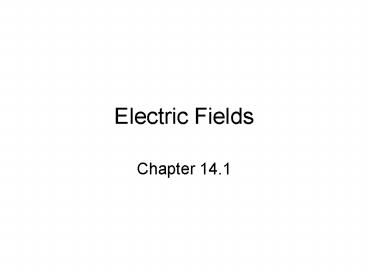Electric Fields PowerPoint PPT Presentation
1 / 15
Title: Electric Fields
1
Electric Fields
- Chapter 14.1
2
What do you already know about charged particles?
- Like charges repel.
- Opposite charges attract.
- Electric charges exert a FORCE on each other
(similar to how masses exert a gravitational
force on each other).
3
Inverse Square Law
- Recall that gravity follows the inverse square
law with respect to the distance between objects
(Universal Law of Gravitation) - We see the same behaviour with charges
4
Coulombs Law
- Is similar to Newtons Universal Law of
Gravitation - Uses the following quantities
- k Coulombs constant (Nm2/C2)
- k 8.99109 Nm2/C2
- q1 q2 charge in coulombs on each object (C)
- r distance between objects (centre to centre)
(m) - However, unlike the gravitation law, it is
possible to have both positive and negative forces
5
Coulombs Law
- Calculates ELECTROSTATIC force
- Electric charges exert forces on each other
6
What exactly is a Coulomb?
- A measure of electric charge equal to the charge
of 6.25 x 1018 electrons - Therefore 1 electron (or proton)
- 1.60x10-19C
- A Coulomb is known as elementary or fundamental
charge. It is the smallest indivisible amount of
charge. All charges are multiples of elementary
charge.
7
Prefixes
- A Coulomb is a relatively large amount of charge.
Often we want to express smaller amounts. You
should know the following prefixes for this unit - 1.0 x 10 -6 C 1 microCoulomb (µC)
- 1.0 x 10-9 C 1 nanoCoulomb (nC)
- 1.0 x 10-12 C 1 picoCoulomb (pC)
- 1.0 x 10-15 C 1 femtoCoulomb (fC)
8
Coulombs Law
- Positive force and repulsion will result when you
have - Two positively charged particles
- Two negatively charged particles
- Negative force and attraction will result when
you have - One positively and negatively charged particle
- Electrostatic force is a non-contact force that
gets smaller the farther two charges are away
from each other.
9
Fg vs Fe
- Differences Fg is only a positive force but Fe
can also repel. - Fg is much weaker than Fe
10
Example
- A small sphere carrying a charge of -8.0µC exerts
an attractive force of 0.50N on another sphere
carrying a charge with a magnitude of 5.0 µC. - a) What is the sign of the second charge?
- b) What is the distance between these two
spheres? (distance of separation) - a) positive
- b) 0.85 m
11
Practice Problems
- Page 638
- 1-5
12
Example 2 3 Charges
- What is the net electrostatic force on B?
13
- Step 1 Free Body Diagram of B
- (NOTE Signs indicate if the force is attractive
or repulsive NOT DIRECTION on the x-y plane
therefore the diagram is very important ). - Step 2 Find the electrostatic forces on B from
the other charges. - Step 3 Vector Addition find the force and
direction (tan) - Answer 1.0 x 102 N E 32.6 S
14
Example 3 4 Charged Particles
- Find Fnet on A
- Fab 0.01N
- Fac 0.00144N
- Fad 0.00212 N
15
- Fab 0.01N
- Fac 0.00144N
- Fad 0.00212 N
- Answer 9.49 x 10 -3 N 69.9

